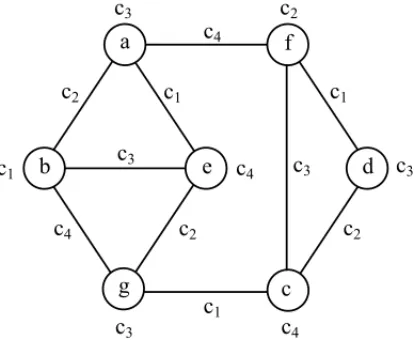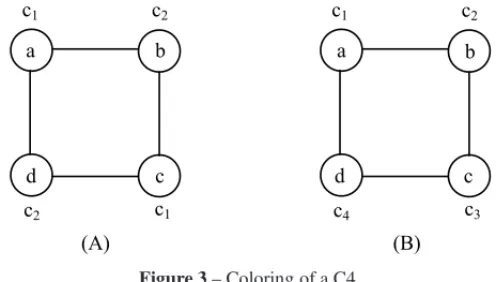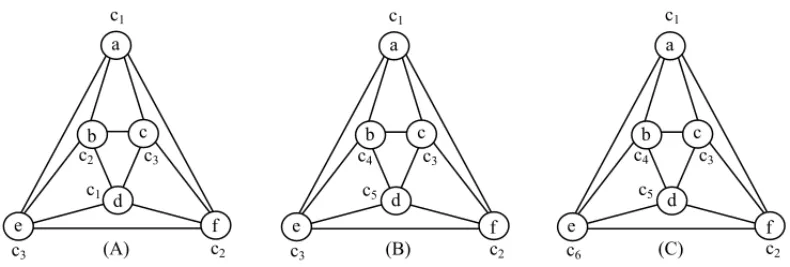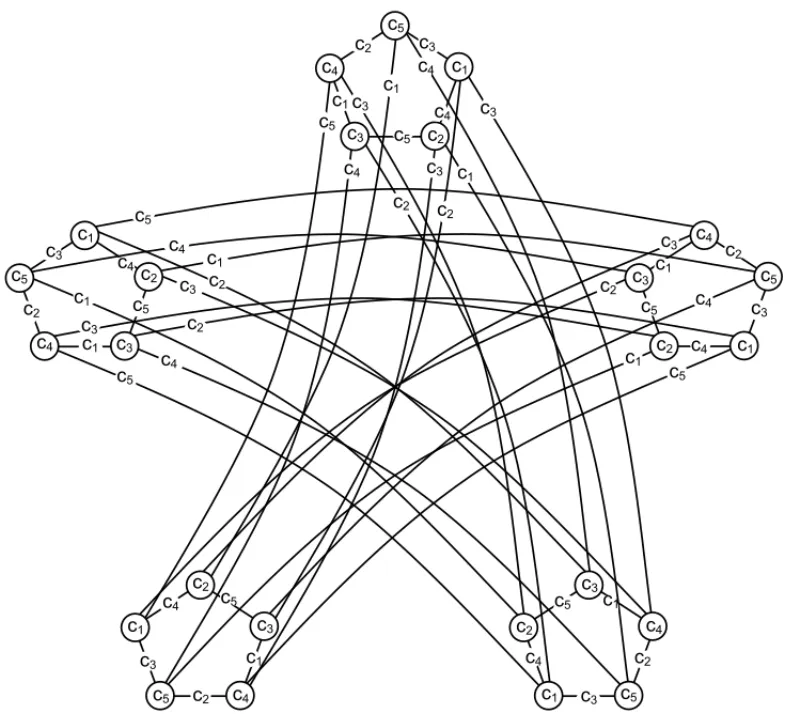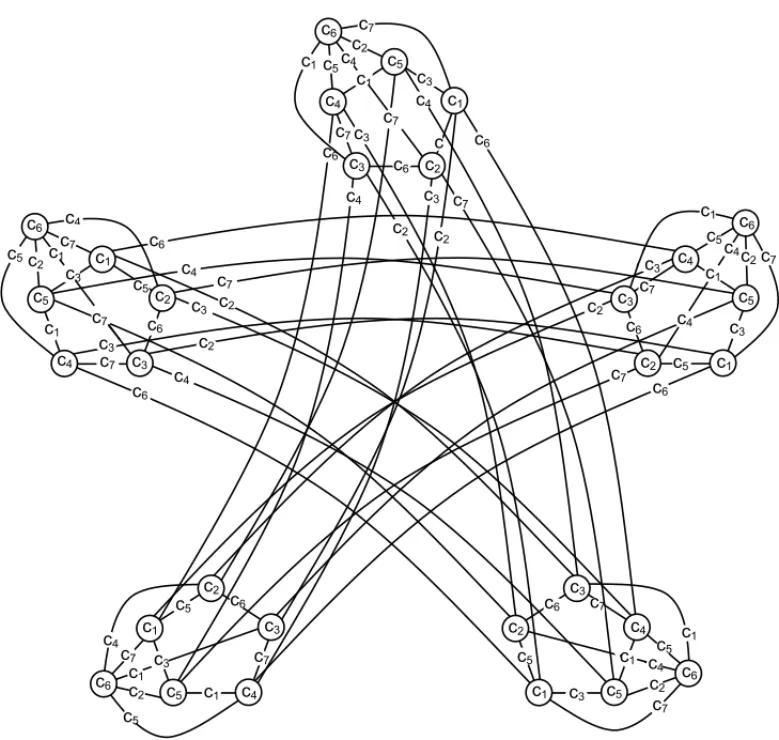doi: 10.1590/0101-7438.2016.036.01.0101
RELATIONSHIP BETWEEN EQUITABLE TOTAL COLORING AND RANGE COLORING IN SOME REGULAR GRAPHS
Abel Rodolfo Garc´ıa Lozano
1*, Angelo Santos Siqueira
2,
Cl´ıcia Valladares Peixoto Friedmann
3and Samuel Jurkiewicz Jurkiewicz
4Received February 18, 2015 / Accepted March 21, 2016
ABSTRACT.This work aims to study the equitable total coloring into subfamilies of regular graphs. For this purpose, we use some relationships between equitable total coloring and range (vertex) coloring in some regular graphs. The concept of range coloring of orderkwas first presented by Lozano et al. (2009). In this paper, we shows that if a regular graphGadmits an equitable range coloringcof orderwith
(+1)colors then there is an equitable total coloring ofG– with the same set of colors – that extendsc. We also show that there are infinite graphs satisfying this theorem. Such graphs are called Harmonics. We generate Harmonic Graphs which are Cartesian products of cycles and their complements. These graphs are regular and they admit an equitable total coloring under the above conditions.
Keywords: equitable total coloring, range coloring, regular graphs.
1 BASIC CONCEPTS AND NOTATIONS
In this section, we present some basic definitions and notations used in this paper, and that can be found in Bondy & Murty (1976), Diestel (1997) or Yap (1986). LetG(V,E)orG denote a graph with vertex setV and edge setE. All graphs considered in this text are finite and simple.
1.1 Basic concepts
A graphG(V,E)isk-regularif all its vertices have the same degreek. Acomplete graphon nvertices is a(n−1)-regular graph; and it is denotedKn. Let M be a matching in a graphG; a vertexv ofG is said M-saturatedbyG if some edge of M is incident tov; otherwisev is M-unsaturated. A matching that saturates all vertices ofGis called aperfect matching.
*Corresponding author.
1Departamento de Matem´atica da FFP/UERJ. Programa de P´os-Graduac¸˜ao em Ensino das Ciˆencias da ECE-LAH/UNIGRANRIO, Rio de Janeiro, RJ, Brasil. E-mail: arglozano@terra.com.br
2Programa de P´os-Graduac¸˜ao em Humanidades, Culturas e Artes da ECELAH/UNIGRANRIO, Rio de Janeiro, RJ, Brasil. E-mail: asiqueira@unigranrio.edu.br.
1.2 Notations
LetGbe a graph. We will adopt the following notations:
dG(v)ord(v)denotes the degree of a vertexv ∈G.
δ(G)orδdenotes the minimum degree ofG.
(G)ordenotes the maximum degree ofG.
NG(v)orN(v)denotes the open neighborhood of a vertexv∈G.
In the next two following sections, we will present other definitions that are relevant to understand this paper.
2 CARTESIAN PRODUCT OF GRAPHS
TheCartesian productGH of two graphsGandH with vertex setsV(G)andV(H)is the graph such that its vertex set isV(G)H(G). Any two vertices(g,h)and(g′,h′)of theGH are adjacent wheneverg=g′andhis adjacent toh′inHorh =h′andgis adjacent withg′in G. This definition can be found in Kemnitz & Marangio (2003), Seoud et al. (1997) or Zmazek & Zerovnik (2002).
Figure 1 illustrates the Cartesian productP3C4of the Path 3 and the Cycle 4.
=
u0u1
u2
u0v0 u0v1 u0v2 u0v3
u1v0 u1v1 u1v2 u1v3
u2v0 u2v1 u2v2 u2v3
v0 v1
v2
v3
Figure 1– Cartesian productP3C4of a path of 3 vertices and a cycle of 4 vertices.
3 VERTEX COLORING, TOTAL COLORING AND EQUITABLE TOTAL
COLORING
Let us consider a graphG(V,E), a set S⊂(V ∪E)and a finite set of colorsC.
A coloringc: S → CofGisproperif no two adjacent elements ofSshare a common color ofC. IfS =V then the proper coloring is avertex coloring. IfS = EorS =V ∪Ethen we have, respectively, anedge coloringand atotal coloring. In this paper, all colorings are proper.
A coloringcis equitableif for everyc1,c2∈C,|a(c1)−a(c2)| ≤1, wherea(c1)= |c−1(c1)|
The smallest numberksuch thatGhas a vertex coloring withkcolors is the chromatic number ofG, denoted byχ(G)orχ. We can extend this definition toedge chromatic numberofGand tototal chromatic numberofG. They are denoted respectively byχ′(G)orχ′andχ′′(G)or χ′′.
Theequitable chromatic number ofG, denoted χe(G)orχe is the smallest numberk such that G has a vertex equitable coloring with k colors. Also, we can extend this definition to
edge equitable chromatic numberand tototal equitable chromatic numberofG. They are denoted respectively byχe′(G)orχe′andχe′′(G)orχe′′.
These concepts can be studied with more details in Chen et al. (1994a), Chen et al. (1994b), Chen et al. (1996), Chunling et al. (2009), Hilton & Werra (1994), Lozano (2005), Lozano et al. (2008), Siqueira (2011), Wang & Zhang (2000) and Yap (1996).
Figure 2 illustrates a 4-equitable total coloring with the colorsc1, c2,c3 andc4. Observe that
a(c1)=a(c2)=a(c4)=4 anda(c3)=5. In this case,χe′′(G)=4.
c
1c
3c
4c
3c
4c
2c
3c
2c
3c
1c
4c
2c
1c
4c
1c
2a
b
c
d
e
f
g
c
3Figure 2– A 4-equitable total coloring.
Clearly, for any graphG,χ′′≥+1 andχ′′≥χe′′. Then the equitable total chromatic number has the same lower bound as the total chromatic number ofG. The Conjecture of Wang for equitable total coloring, in Wang (2002), says thatχe′′ ≤+2, i.e. thus, it is desirable to find a total equitable coloring that meets the conjecture.
LetG(V,E)be a graph;CandC′finite sets of colors(C ⊂C′);c: V →Ca vertex coloring ofG; andc′:(V ∪E)→C′a total coloring ofG. We say that the coloringc′extendscorc′is an extension ofcif, for allv∈V,c′(v)=c(v).
4 RANGE COLORING
In this paper, the same technique helps us to get a total equitable coloring for a family of regular graphs, which are Cartesian products of Cycles and their complements. Before that, we define range coloring of orderkand range chromatic number of orderkof a graph.
LetG =(V,E)be a graph andk ∈ N. A vertex coloringc: V → C ofGis called arange vertex coloring of order k of G, if for all v ∈ V such thatd(v) = k, |c(N(v))| = d(v); otherwise|c(N(v))| ≥k, where|c(N(v))| is the number of colors appearing in the open neigh-borhood ofv.
Observe that, in a range coloring of orderk, vertices of degree less than or equal to the required range must have all their neighbors colored with distinct colors, and vertices of degree greater thankneed at leastkcolors in their neighborhood. Moreover, ifk=1 we have the usual vertex coloring,k=is equivalent to a 2-distance coloring and it is an upper bound for the order of a range coloring.
Figure 3 below illustrates the coloring of a cycle of 4 vertices (C4). In 3(A), a usual vertex coloring of the cycle is shown while in 3(B) the coloring of the vertices is of range 2.
a
c b
d
a
c b
d
(A) (B) c1
c1 c2
c2 c3
c1 c2
c4
Figure 3– Coloring of a C4.
A graphGist-range colorable of orderkif there is a range coloringcof orderkthat usest colors. Therange chromatic number of orderkofG, denotedχkf(G), is the smallest value of t for whichGist-range colorable of orderk.
Figure 4 shows range colorings of different orders for an octahedron. In 4(A), the range coloring is of order 2 and χ2f(G) = χ(G) = 3. Figure 4(B) shows a range coloring of order 3 and χ3f(G)=5. Finally, in Figure 4(C), the range coloring is of order 4 andχ4f(G)=6.
5 RELATIONSHIP BETWEEN THE EQUITABLE TOTAL COLORING AND
THE RANGE VERTEX COLORING IN SOME REGULAR GRAPHS
(B) (A)
a
d
f b
e
c
a
d
f b
e
c
(C) a
d
f b
e
c c1
c2 c2 c3
c1
c3
c1
c2 c4 c3
c5
c3
c1
c2 c4 c3
c5
c6
Figure 4– Range coloring of order 2, 3 and 4, respectively.
(+1)colors, then there is a total coloring ofGsatisfying the Vizing-Behzad Conjecture. It is a particular case of the Theorem 1. The third theorem proves that a range coloring of order, using+1 colors, of a regular graph is equitable. The fourth one shows that if a range coloring of a regular graphGis of order, using+1 colors, then the total coloring of the graph satisfies the Wang’s Conjecture and it is equitable.
We suggest the nameHarmonic Graphfor any regular graph that has a range coloring of order , using+1 colors. At first, one might think that there are few Harmonic Graphs, but Lozano et al. (2013) showed ways to obtain some of these graphs.
The last theorem of this section proves that the Cartesian product of Cycles and their comple-ments are Harmonic Graphs. As a consequence of Theorem 4, the total coloring of these graphs is equitable and they meet the Wang’s Conjecture.
Theorem 1 (7).Let G(V,E)be a graph with maximum degreeand c:V →C = {1,2, . . . ,t}
a range coloring of orderof G. Then, there is a total coloring of G with at most(t+1)colors.
Theorem 2.Let G(V,E)be a graph with maximum degreeand c:V →C = {1,2, . . . , +
1}a range coloring of orderof G. Then, there is a total coloring of G satisfying the Total Coloring Conjecture.
Proof. LetH+1(V′,E′)be the complete graph of order(+1). It is known that H+1can
be totally colored with(+1)or(+2)colors and its vertex coloring is a range coloring of order(+1). Letc′:V →C′= {1,2, . . . , +2}be a total coloring ofH+1. Without loss of
generality, we identify each vertex ofH+1with the color associated to it by the total coloring
c′such that the color of each vertex ofH
+1belongs to the set{1,2,3, . . . , +1}.
We use the total coloringc′of H+1to extend the range coloringcof orderof the vertices
of graphG to a total coloring ofG. First, we define the mapping f : V → V′ : f(u) = i wherei is the vertex of H+1 such thatc(u) = c′(i) = i. Now, for each edgeuv ∈ E, we
definec(uv)=c′(f(u)f(v)). The coloring defined is proper, since if two edgesuvanduv′are
thenc(uv) = c(uv′). On the other hand, ifuv ∈ E is an edge incident on vertexv ∈ V, then c′(f(v)) =c′(f(u)f(v)), thereforec(v) =c(uv).
The total coloring obtained by the technique used in the proof of Theorem 2 is called the natural extension of a range coloring of orderofG.
Theorem 3. Let G(V,E)be a regular graph, and c : V → C = {1,2, . . . , +1}a range coloring of orderof G. Then:
a) +1divides|V|;
b) Each color i ∈C, is used exactly|V+|1 times.
Proof. For each colori ∈C,Viis the set of vertices with coloribyc. In order to proceed the demonstration, the following facts have to be observed:
Fact 1. For alli ∈ C, Vi is an independent set ofV. Asd(v) = , (remember thatGis a regular graph), all colors ofC− {c(v)}are used in the neighborhood of vertexv(N(v)), i.e. , if c(v) =i, there is a vertexu ∈Vi∩N(v).
Fact 2. For everyi ∈C, if two verticesu, v∈ Vi thenN(u)∩N(v)=∅. As a consequence of a range coloring of order, all neighbors of any vertexwofGmust have different colors.
Now, given i,j ∈ C, withi = j, let f : Vi → Vj be a mapping constructed as follows:
f(u)=v, if and only ifv∈Vj∩N(u).
According to the Facts 1 and 2, the mapping f is a bijection. Then|Vi| = |Vj|and the assertions a) and b) of theorem are direct consequences of this result.
Observe that the above range coloring of order ofG is equitable. Now, we prove that the natural extension of the range coloring of orderofGis an equitable total coloring ofG.
Theorem 4. Let G(V,E)be a regular graph, and c : V → C = {1,2, . . . , +1}a range coloring of orderof G. Then the natural extension of c is an equitable total coloring.
Proof. We namec′a natural extension of the coloringcof the graphGandC′the set{1,2, . . . , +2}. For each colori ∈C′,Ei is the set of edges with the coloribyc′. This proof is divided into two cases:
Case 1. The color(+2)was not used in the total coloring, thenis even. Some facts are taken into consideration:
Fact 3. Giveni ∈Candv∈V;c(v) =ithen there is an edgee∈Ei, such thatvis an end of
Fact 4. Giveni ∈ C, let beV′ = V −Vi and let G′(V′,E′)be the subgraph ofG induced byV′ and considerc′′the restriction of coloringc′toG′then Ei is a perfect matching of G′. Remember that a perfect matching is the one that covers all vertices ofG′. The edge set Eiis a matching because it is a proper coloring and it is perfect according to Fact 3.
As a consequence of Facts 3 and 4, each colori ∈ C is used exactly |V−Vi|
2 times in the edges
which it proves that|V −Vi|is even.
Case 2. The color(+2)was used, thenis odd.
Fact 5. For every vertexv∈V, there is an edgeeincident tovassociated to color(+2). To prove it, just remember that for each vertexu∈ V,dG(u)=dH+1(f(u))=, whereH+1is
the complete graph of order(+1). Therefore, the set of colors used to color the edges incident onu in graphGis exactly the same set used for coloring the edges incident on f(u)on graph H+1; and that color(+2)is used on some edge incident on f(u). Thus, the color(+2)is
used |V2| times, since|V|is even, becauseGis regular of odd degree.
On the other hand, each colori ∈ {1, . . . , ( +1)} is used on the edges of H+1 exactly
−2
2 times, i.e., it is not used on the edges incident on the vertex with the coloriand it is not used
at any other vertex. We nameg(i)the color of this vertex, then a colori ∈ {1,2, . . . , (+1)}
appears at the edges ofGexactly
k= |V| −(|Vi| + |Vg(i)|)
2
times, but|Vi| = |Vg(i)|, thenk= |V|−(22|Vi|), and as|Vi| = |V+|1it follows that
|V| −2|Vi| = |V| −2
|V|
+1 =
(−1)|V|
+1 , where k=
(−1)|V|
2(+1) .
Now, we have that coloriis used at the total coloring
k= |V|
+1+
(−1)|V|
2(+1) = 1
+1
|V| + (−1)|V|
2
= 1
+1
(+1)|V|
2 =
|V|
2
times, so the coloring is equitable.
Now, we show how to construct some Harmonic Graphs which are Cartesian product of Cycles and their complements.
Theorem 5.The Cartesian product of a Cycle Cn and its complement is an Harmonic Graph.
Proof. First, we note thatKm+1satisfies the conditions of the theorem.
Forn=3, the theorem is trivial, because the vertex coloring obtained from the cycleC3satisfies
the conditions of the theorem, i.e. theC3 naturally admits a range coloring of order 2, with
Let be an arbitrary natural numberm. Consider a cycleCn1,n=m+1. Let beV = {v1, . . . , vn} its vertices andC = {c1, . . . ,cn}a set of colors. Without loss of generality, we assume that the
n vertices of the cycle were colored by the mapping f1 : V(Cn1) → C, where, f1(vi) = ci,
i =1, . . . ,n.
The next step is to construct (n −1)copies Cn2, K, Cnm ofCn1, and define the coloring fi :
V(Cin)→C, where fi(vj)=ck,k=(j+(n−i)) modn+1,i,j =1, . . . ,n.
Note that for each vertexvj in the cycleCin, the colors used on their neighbors in the cycle are the same ones used to color their copies in cyclesC(ni+1) modnandC(ni−1) modn. The neighbors are exactly the vertices adjacent to vertexvj inCin. For each remaining(n−3)copies ofvj, different colors were applied, which are different of the ones that were used invj and its neighbors in the cycle Cni. We can add an edge joiningvj to each of its copies, which are located at different cycles of Cni, Cn(i+1) modn, and Cn(i−1) modn. The resulting coloring is also a range color of order.
Originally, the graph was 2-regular and(n−3)edges were added at each vertex. The resulting graph is regular of degree(n −1)= m, colored withn =(+1)colors and range(n−1).
Then it is an Harmonic Graph.
From Theorem 4, we have that the total coloring of the Cartesian Product of a CycleCnand its complement is equitable. Figure 5, bellow, illustrates the equitable total coloring of Cycle Cn and its complement.
Observe that it is always possible to increase the degree of this kind of Harmonic Graph while keeping the equitable total coloring. LetG(V,E)be ann-harmonic graph, constructed from a cycle, andc: V → Can equitable coloring ofGusing(G)+1 colors. We will construct a graphG′(V′,E′)as follows:
Let beV′ = V ∪ {u
11, . . . ,u1n, . . . ,uj1, . . . ,uj n, . . . ,us1, . . . ,usn} and Ei = {e = {x,y :
x=uj i and (y=uki ory=vt i);t,k∈ {1, . . . ,n}, j ∈ {1, . . . ,s},k∈ j}}, wherev1i, . . . , vni are the vertices of the cycleCin,i =1, . . . ,n. LetE∗ =n
i=1EiandE′=E∪E∗.G′satisfies
the conditions of Theorem 5. In fact,(G′)=(G)+m, thenc′(v)=
c(v) ifv∈V
c+j+1 ifv=uj i is an equitable coloring ofG′using(G′)+1 colors.
Figure 6, bellow, shows the equitable total coloring of a 5-regular graph from a harmonic graph, constructed from a 5-cycle.
6 CONCLUSIONS
c1
c5
c4 c3
c4 c4 c5 c1 c2 c3 c5 c2 c4 c1 c2
c1 c
5 c3 c2 c3 c4 c2 c2 c1 c3 c1 c3 c5 c4 c2 c3 c5 c3 c2 c4 c4 c3 c1 c5 c1 c4 c2 c5 c1 c3 c5 c2 c3 c4 c1 c1 c3 c2 c4 c5 c2 c1 c3 c4 c5 c1 c3 c4 c5 c2 c1 c2 c3 c4 c5 c1 c2 c3 c4 c5
Figure 5– Equitable total coloring of the Cartesian product of C5 and its complement.
it is likely to emerge the following questions: Besides the Complete Graphs, are there any other Harmoni Graphs? Can we build Harmonic Graphs, easily?
The Cycles whose number of vertices is a multiple of three are examples of Harmonic Graphs, as well as the Cube. In this paper, we have presented an efficient way to get other Harmonic Graphs: we constructed Harmonic Graphs which are Cartesian products of Cycles and their complements. Such graphs, in general, show an interesting relation between a graph of few edges (Cycle) with other of many edges (the complement of the Cycle). The generation of Harmonic Graphs is not limited only to the ones shown along this paper. In case the reader is interested to obtain further information, consult Lozano et al. (2013), as already mentioned.
c1
c5
c4 c3
c5 c4 c6 c7 c2 c3 c6 c2 c4 c7 c1
c7 c
6 c3
c2 c 3 c c1 c2 c c3 c7 c3 c6 c4 c2 c3 c6 c6 c2 c4 c4 c3 c1 c5 c7 c4 c2 c5 c1 c3 c6 c1 c3 c5 c7 c7 c3 c2 c4 c6 c2 c1 c3 c4 c5 c7 c3 c5 c6 c1 c1 c2 c3 c4 c6 c7 c1 c3 c5 c5 c6 c6 c6 c6 c6 c7 c7 c4 c1 c2 c5 c7 c2 c4 c5 c1 c1 c5
c2c7 c4 c1 c5 c2 c7 c4 c4 c7 c2 c5 c1
Figure 6– Equitable total coloring of a 5-regular graph from a 5-harmonic.
REFERENCES
[1] BONDYJA & MURTYUSR. 1976. Graph Theory with Applications. New York: North-Holland.
[2] CHENBL & LIHKW. 1994a. Equitable coloring of trees.Journal of Combinatorial Theory, Series B,61: 83–87.
[3] CHENBL, KO MT, LIH KW & WU PL. 1994b. Equitable coloring and the maximum degree. European. J. Combinatorics,15: 443–447.
[4] CHENBL, KOMT, LIHKW & WUPL. 1996. Equitable and m-bounded coloring of split graphs. Combinatorics and Cumputer Science, Lecture Notes in Computer Science,1120: 1–5.
[5] CHUNLINGT, XIAOHUIL, YUANSHENGY & ZHIHEL. 2009. Equitable Total Coloring deCmCn. Discrete Applied Mathematics,157: 596–601.
[7] FRIEDMANNCVP, MARKENZONL, LOZANOARG & WAGAC. 2011. Total Coloring of Block-Cactus Graph.Journal of Combinatorial Mathematics and Combinatorial Computing,78: 273–283.
[8] HAJNALA & SZEMEREDI´ E. 1970. Proof of a conjecture of Erd¨os.Combinatorial Theory and Its Applications2. In: Colloq. Math. Soc. J´anos Bolyai 4, Amsterdam, Netherlands: North-Holland, 601–623.
[9] HILTONAJW & WERRAD. 1994. A sufficient condition for equitable edgecolourings of simple graphs.Discrete Math.,128: 179–201.
[10] KEMNITZ A & MARANGIOM. 2003. Total colorings of cartesian products of graphs.Congres. Numer.,165: 99–109.
[11] LOZANOARG. 2005. Colorac¸˜ao total equilibrada de grafos. Tese de Doutorado, COPPE/UFRJ, Rio de Janeiro, RJ, Brasil.
[12] LOZANO ARG, FRIEDMANNCVP & JURKIEWICZS. 2008. Colorac¸˜ao Total Equilibrada – Um Modelo para Redes de Interconex˜ao.Pesquisa Operacional,28(1): 161–171.
[13] LOZANOARG, FRIEDMANNCVP, WAGAC & MARKENZONL. 2009. Colorac¸˜ao de V´ertices com Folga. In: XLI Simp´osio Brasileiro de Pesquisa Operacional, Porto Seguro. Anais do XLI SBPO, 3084–3091.
[14] LOZANOARG, SIQUEIRAAS, JURKIEWICZS & FRIEDMANNCVP. 2013. Produto Funcional de Grafos.Tendˆencias em Matem´atica Aplicada e Computacional,14(2): 1–12.
[15] SEOUD MA, ABD EL MAQSOUD AEI, WILSONRJ & WILLIAMS J. 1997. Total colouring of cartesian products.Int. J. Math. Educ. Sci. Technol.,4(28): 481–487.
[16] SIQUEIRA AS. 2011. Colorac¸˜ao total equilibrada em subfam´ılias de grafos regulares. Tese de Doutorado, COPPE/UFRJ, Rio de Janeiro, RJ, Brasil.
[17] WANG WF & ZHANGK. 2000. Equitable colorings of line graphs and complete r-partite graphs. System Sci. Math. Sci.,13: 190–194.
[18] WANGWF. 2002. Equitable Total Colorings of graphs with Maximum Degree 3.Graph and Combi-natorics,18: 677–685.
[19] YAPHP. 1986. Some topics in graph theory. London: Cambridge University Press.
[20] YAPHP. 1996. Total colorings of graphs. Berlin: Springer.

